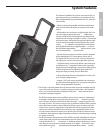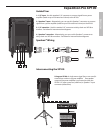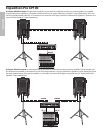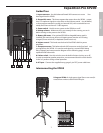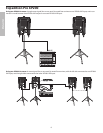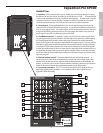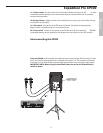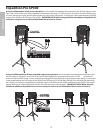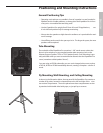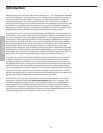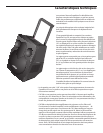
10
Expedition Pro XP300
6: Line inputs - Use these 1/4" jacks to connect line-level sources to the XP300. Channels 1 and 2 are
mono 1/4" connectors; channel 3/4 uses a stereo (TRS) 1/4" connector, with tip carrying left signal and
ring carrying right signal. Stereo devices should always be connected to the stereo channel (channels
3/4). If a wireless receiver is connected to the XP300 via its internal connectors (see page 14 in
this manual), its output arrives at channel 2, which can also carry another line-level source connected
to its line input, as well as signal from a microphone connected to its mic input. If an optional TD30
cassette player is installed, its output arrives at channels 3/4, which can also carry another two line-level
sources (one connected to its line input and a second connected to the CD inputs [see #15 on the fol
-
lowing page]), as well as signal from a microphone connected to its mic input.
7: Mic inputs - Use these XLR jacks to connect microphones to the XP300’s built-in mic preamps.
Each channel can carry both one or more line level sources (see #6 above) as well as a mic source.
8: DSP Effects control - Use this to select one of six reverb presets (Small Hall, Medium Hall, Large Hall,
Church, Stadium, or Plate). If you don’t want to hear any reverb, set this switch to the “Off” position.
9: Mono/Stereo switch - When using one XP300, set this switch to “Mono” so that the XP300 power
amp receives signal from both the left and right output sections. When using multiple Expedition Pro
speaker enclosures, set this switch to “Stereo”; the XP300 will then reproduce only signal from the left
output section only (that is, signals panned left at the mixer); the Right output can then be used to send
signal from the right output section (that is, signal panned right at the mixer) to a second enclosure.
See the interconnection diagrams on pages 10 - 11 for more information.
10: Outputs - The dual XLR connectors carry line-level output signal from the XP300. They are used to
send signal to a second XP300 (or XP200) being daisy-chained (see the interconnection diagram on the
following page) or to an optional EX500 subwoofer. Note that the signal being output from these con
-
nectors is dependent upon the setting of the Mono/Stereo switch (see #9 above). When set to “Stereo,”
the Left XLR connector carries left signal only and the Right XLR connector carries right signal only;
when set to “Mono,” both the Left and Right connectors carry the same monophonic signal, summed
from both the left and right output sections. See the interconnection diagrams on pages 10 - 11 for
more information.
11: Main Volume control - This knob determines the final output signal level—you can think of this as
being the “master fader.” Signals from all four channels are routed here just before being routed to the
XP300’s built-in power amplifiers and Left and Right output jacks (see #10 above).
12: Battery VU meter - If an optional RB 2030 rechargable battery pack is installed, this meter shows
how much battery power remains as it is being charged (Power switch off) or depleted (Power switch
on). See #20 on the following page.
13: Output VU meter - This three-segment bar meter shows the continuous output level of the XP300.
For optimum signal-to-noise ratio, try to adjust all channel and main Volume controls so that program
material is usually at or around 0 VU, with occasional but not steady excursions to the red “+3 dB” seg
-
ment.
14: Limiter LED - Lights whenever the built-in limiter is active. If you see this lighting frequently, it
means you’re overloading the XP300, so turn down one or more of the Channel volume controls (see #4
on the preceding page) or the main Volume control (see #11 above).
15: CD inputs - Connect the outputs of a CD or tape player to this set of dual phono jacks. Signal
arriving here returns to stereo channel 3/4. If an optional TD30 cassette player is installed, note that its
output also arrives at channels 3/4, in addition to line-level signal arriving at its 1/4" TRS line input (see
#6 on the preceding page) and signal from a microphone connected to its mic input (see #7 on the pre
-
ceding page).
16: AC input - Connect the supplied heavy-gauge 3-pin “IEC” power cable here.
ENGLISH
10




